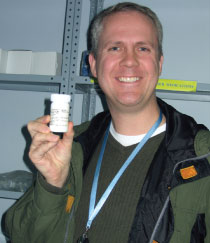Number of people living with HIV/AIDS, worldwide: more than 31 million. Of that, 22.5 million live in sub-Saharan Africa. To say HIV/AIDS is an epidemic—especially in Africa—is an understatement. More importantly, the number of known cures or vaccines: zero.
But thanks to the research of Michael Thigpen (’91), one little pill may be one major step forward.
“HIV has ravaged health care throughout Africa,” says Thigpen, a medical epidemiologist with the Centers for Disease Control and Prevention and a 2010 Alumni Promise Award winner. “But it’s no longer a death sentence for those who have it. We now have very effective and easy-to-take medications to treat people who already have HIV. But as an estimated 2.6 million people worldwide were infected with HIV in 2009, we need better ways to prevent it.”
Thigpen’s AIDS research was actually inspired by his research of another disease. While completing fellowship training in infectious diseases at Emory University, he worked with the CDC on a project in Malawi in eastern Africa to determine how best to protect pregnant women from getting malaria, which Thigpen says “can lead to having infants born too early or too small, factors which contribute to early infant death.”
“While the medication our project used prevented malaria, it didn’t work as well in women who were also infected with HIV,” he says. In 2005, Thigpen began working in Malawi and Kenya to find better ways to prevent infants from getting HIV from their infected mothers, who can pass the virus to their children before or during delivery or during breastfeeding.
“We wanted to make breastfeeding safer so infants could get the positive benefits of breast milk, such as good nutrition and antibodies from their mothers, while preventing them from getting HIV,” Thigpen says. The research was successful and was able to prevent HIV in the infants nearly 75 percent of the time. “But the best way to prevent infants from getting HIV is to prevent their mothers from also getting HIV.”
Preventing HIV for women in Africa is crucial. Of the 22.5 million people living with HIV/AIDS in sub-Saharan Africa, more than half are women.
“Women continue to bear the brunt of the HIV epidemic throughout much of Africa,” Thigpen says. In Botswana, about 50 percent of women in their 30s and 40s are infected, and preventing HIV is difficult due to cultural attitudes.
Thanks to a study led by Thigpen, that option may be Truvada—a drug already used to treat people living with HIV—and could be the breakthrough the AIDS epidemic needs. The study enrolled more than 1,200 HIV-negative Botswana citizens, who were randomly prescribed either Truvada or a placebo (that is, a sugar pill) to see if Truvada was safe and effective for preventing HIV. Thigpen’s team monitored the patients monthly to see if they became HIV-infected and provided them with condoms, counseling, and medical care. All told, Truvada kept more than 60 percent of the volunteers from being infected with HIV.
Despite the promising results, Thigpen and his colleagues know Truvada isn’t a cure-all and isn’t as effective as a vaccine.
“An effective vaccine may still be years away,” Thigpen says. “In the meantime, we continue to look at the best strategies for preventing people from getting HIV. Although this research looks very promising in the context of a research study, we need to see how well these interventions work in the real world.
“In the end, a combination of approaches—such as anti-HIV medications, condoms, risk behavior change, anti-HIV vaginal gels, and male circumcision—will likely be needed to change the tide of the HIV epidemic.”

